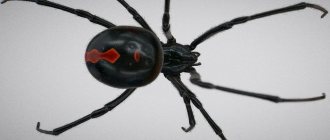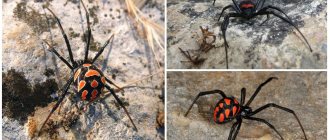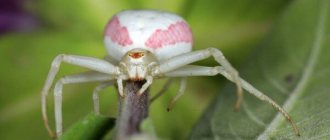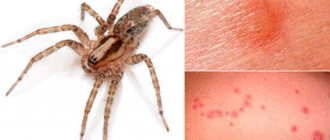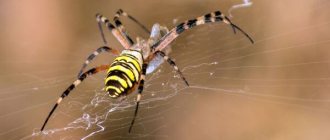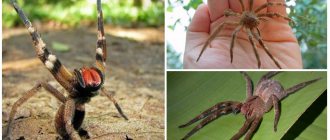Why is the karakurt spider called the “black widow”?
This name is given not only to female spiders, but to the entire species as a whole. The reasons that they received this name are two facts:
- spiders are black with red spots on the abdomen. By the way, adult females may lack spots, which is why they become pure black, making them even more similar to a black widow;
- immediately after mating, the female eats her male (in the vast majority of cases).
Characteristics of the karakurt spider
Karakurt spider, appearance
Spiders of this species have a ball-shaped abdomen and a cephalothorax. They are connected to each other by the seventh segment of the cephalothorax. From the abdomen come two pairs of jaws and four pairs of legs. The female has two upper jaws (chelicerae), at the ends of which there are hooks. On the other side of the jaws are poisonous glands.
As already mentioned, they are black in color and most often have red spots on the abdomen. Over time, females may lose their red spots, and yellow stripes may also appear. It depends on their habitat. Eurasian female karakurts are solid black, while American and Australian ones always have spots.
A distinctive feature of this species is pronounced sexual dimorphism: the female is 3-4 times larger than the male. On average, the size of males is only 5-7 mm, and females are up to 20 mm.
It is also interesting that the karakurt spider has blue blood, not red, since blue (copper) hemocyanin is responsible for its formation.
Habitat of the karakurt spider
Since the bite of this type of spider is incredibly dangerous, it is of course important to know where they live in order to protect yourself.
Spiders prefer to be in forest-steppe, steppe and semi-desert zones, where there is a warm climate. They can be encountered in southern Europe, Central Asia and North Africa.
If we talk about countries near Russia, then karakurt spiders live in Azerbaijan, Kazakhstan, and not so long ago they were found in the Donetsk region.
Unfortunately, in Russia itself, spiders are quite widespread. They can be found mainly in the southern regions, located in the steppe zones, namely: In the Rostov, Astrakhan and Novosibirsk regions, Altai Territory and Crimea.
There were isolated cases when these dangerous spiders were encountered in the Moscow region. Due to the extreme heat, spiders migrated to these areas. But they do not stay there, because harsh winters are destructive for karakurt spiders.
Karakurts hide in the steppes, arable lands, wastelands, salt marshes and near ravines. They settle in crevices, burrows, depressions in the ground and walls of adobe houses. Sometimes they can be found in abandoned buildings.
Karakurt, front view
Karakurt spider from the black widow family
Karakurt, black color
Origin of the species and description
Photo: White Karakurt
The white karakurt belongs to the arachnid arthropods, is a representative of the order of spiders, the family of web spiders, classified in the genus of the black widow, the species white karakurt.
Scientists do not have reliable information about the origin of these representatives of arthropods. The most ancient finds of the distant ancestors of the Karakurts date back to the Carboniferous Age, which is about four hundred million years ago. They are rightfully considered representatives of some of the most ancient living creatures preserved on earth.
Video: White karakurt
Some scientists suggest that the most ancient ancestors of modern poisonous spiders, including karakurts, lived in water. However, during the Paleozoic period, they moved into thickets of huge grass and impenetrable bushes. In thickets of dense vegetation they hunted various insects. Later, spiders appeared that could weave webs and entangle eggs with them for protection.
About two hundred and fifty million years ago, arthropods appeared that learned to weave webs to create traps. With the onset of the Jurassic period, spiders learned to weave multiple webs and hang them in dense foliage. To make webs, arthropods used a long, thin tail.
Spiders spread widely across the earth during the formation of Pangnea. Later they began to be divided into species depending on the region of their habitat.
Reproduction of karakurt spiders
The mating season of spiders occurs in the summer. Having found a secluded place, the spider makes a web, filling it with the scent of its pheromones, which attract the female.
After mating, the female eats the male. Then she looks for a place where she can lay eggs, for example, in rodent burrows or other secluded places.
On average, a clutch contains up to 130 eggs. But sometimes, about once every 10-15 years, there are bursts of reproduction of these dangerous spiders, when the female is able to lay up to 1300 eggs in one season.
The female makes 2-4 cocoons and places eggs in them. She weaves a web and attaches cocoons to it. When the autumn cold sets in, the female dies.
The cocoons reliably protect the eggs from the cold, thanks to which the future offspring of the karakurt survive the winter, and in the spring they get out of it and begin to independently fight for survival.
A strong wind can tear off cocoons, which begin to move under its force, thereby increasing the habitat of this type of spider.
Spiders hatch from eggs 10-15 days after laying, depending on the weather, but remain in the cocoon until spring. First, they feed on the food reserves stored in their bodies, and then they begin to eat each other.
They grow into adults during the spring and summer. In the process of growing up, male spiders go through seven molts, and females go through nine.
Karakurt in the web, photo
Karakurt spider, reproduction
Female karakurt with cubs
Who is dangerous for karakurt?
Despite the fact that this type of spider is considered the most dangerous in the world, and its bite can kill, karakurts have their own enemies who can destroy them.
The natural enemies of karakurts are herd animals. Sheep, cows and horses can trample hectares of steppe and destroy all the spiders living there.
Spiders are the diet of some animals and insects. For example, hedgehogs are not at all afraid of karakurts, because armor made of needles reliably protects them, so they can eat a spider of this species.
The spider nymphs lay their eggs directly into cocoons made by the female black widow, and their larvae eat the spider nymphs.
Sphex wasps attack spiders, inject them with paralyzing poison, and then kill them.
Effect of karakurt poison
A karakurt bite has very serious consequences and can be fatal. The effect of the venom is neurotoxic, which is rare for venomous animals of this size. In addition to neurotoxins, the venom contains a number of enzymes.
Karakurt and its poison are an unusual natural phenomenon. The fact is that large animals such as horses, cows, antelopes, camels, donkeys, and rams are most sensitive to its poison. For humans, this poison is almost fatal, but death does not always occur.
This spider is not so dangerous for hedgehogs, dogs, bats, amphibians, and reptiles.
The introduction of poison has an immediate effect on humans. The following symptoms appear:
- A burning pain appears, quickly spreading throughout the body.
- After 10-15 minutes, the pain is especially localized in the abdomen, lower back, and chest.
- The abdominal muscles tighten sharply. It can be very difficult to relieve such a spasm.
- Shortness of breath, rapid heartbeat, dizziness, severe headache, change in complexion, hand tremors, nausea and vomiting, severe sweating, heaviness in the chest or solar plexus appear.
- The next series of symptoms is in the nature of deep damage to the nervous system. Exophthalmos appears, that is, bulging of the eyes and their displacement to the side. At the same time, the pupils dilate greatly. In men, due to severe spasm, a prolonged erection may occur. All this is accompanied by bronchospasms, delayed defecation and urination, and general psychomotor agitation.
- In the later stages of the action of the poison, convulsive states are replaced by severe depression, clouding of consciousness, and the appearance of delusional states.
If the human body passes all these tests, then the last stage will gradually be replaced by an improvement in condition and complete recovery. The likelihood of death is primarily related to the body’s ability to fight the effects of the poison.
Why is poison needed?
All poisonous animals use their poison to easily obtain food for themselves. Poison for defense is used as a last resort. The fact is that to produce toxic substances it is necessary to waste the body's resources. If a poisonous spider or snake bites an animal that is too large for them, they will not be able to eat anything soon, because some time must pass before the next portion of poison is produced.
All spiders have venom, but most have just enough venom to kill the fly and inject digestive enzymes into it for external digestion. Karakurt does not have the same distribution as, for example, house spiders or cross-web spiders. It seems that karakurts have all the advantages over other spiders, but the number of these most poisonous arthropods in Russia is small.
What is the purpose of such poison? Scientists put forward 2 versions:
- The spider's strong venom is simply an evolutionary flaw. When some advantageous trait is acquired as a result of mutation and selection, it can first appear hypertrophied, and then, after many generations, it weakens or is compensated by a new trait. According to this version, the poison of the karakurt is an evolutionarily young acquisition, which will weaken over time, since such a powerful poison requires too much from the spider’s body.
- Karakurt is often forced to live in conditions where there may be few insects, but there are many ungulates. Some animals, having been bitten by a small karakurt, will not go far from its web. If, for example, an antelope dies nearby, then after a while it will begin to decompose. This means that flies and other insects will fly around such a corpse, feeding on the corpses. As a result, the spiders will be provided with food for several weeks.
How dangerous is a karakurt bite for humans? What to do in this case?
The spider does not purposefully attack a person, but if it feels threatened, for example, someone has touched its web, it will bite. Its bite can be fatal. It is 15 times more dangerous than a rattlesnake bite!
Karakurt males cannot bite through the skin of humans and many species of animals, in addition, they do not have glands with poison, so males are not dangerous, unlike females.
Symptoms of a karakurt bite
They appear quickly, the first signs can be seen after 10-15 minutes.
First, all the muscles in the body begin to ache; it feels like a cold. All the muscles of the chest, abs and lower back hurt.
The heart rate increases, shortness of breath, dizziness, tremors of the limbs and priapism appear in men.
Afterwards, vomiting begins, the body becomes weakened, and the person has poor control of the limbs.
Then nervous exhaustion of the body sets in, and depression may appear. Consciousness becomes cloudy, the victim loses his sense of reality, he ceases to recognize loved ones.
If an antidote is not administered in time after a karakurt spider bite, the person may die.
Is a karakurt bite always so dangerous? Fortunately, no. For example, the highest concentration of poison in spiders is during the mating season and after the female has laid eggs (i.e. in July-August), in other seasons there is less of it, so bites become less dangerous.
In addition, how the body reacts to a bite directly depends on its immunity: the higher it is, the easier it is to endure the bite.
If a person has an increased allergic reaction to poisons, then a spider bite is more dangerous for him.
What to do after a karakurt bite?
The most effective method of treatment if suddenly bitten by a female karakurt (black widow) is cauterization of the wound. But it must be done immediately after the bite (no later than 10 minutes), because the female bites through the skin by only 0.5 mm, so the poison remains on the surface and in the upper layer of the epidermis for some time. Cauterization can destroy the poison and prevent it from spreading throughout the body.
For cauterization, you can use the head of a match or heat any metal object (cutlery, keys, key chains, etc.) over a fire.
After a karakurt bite, you must go to the nearest hospital, even if cauterization was performed. In regions where this type of spider is common, there is almost always a serum that can neutralize the poison.
But you shouldn’t hope that all symptoms will disappear immediately. It will be easier only after 1-3 weeks.
If there is no antidote, then the victim’s condition can be alleviated by injecting potassium permanganate at a concentration of 2-4% or magnesium sulfate at a concentration of 10-15%.
Further, hot baths will help reduce pain, and drinking plenty of fluids will speed up the removal of poison from the body. Painkillers and healthy sleep will have a beneficial effect; if you suffer from insomnia, it is recommended to take sleeping pills.
Karakurt bite: symptoms
Some victims say that within thirty minutes (although usually later) they felt aches throughout their entire body (as if they had a very high fever). The lower back, upper and lower abs begin to ache, the pain increases, becoming unbearable.
After some time, the strength subsides sharply, and weakness falls on the person. The legs weaken first, followed by the arms, and then the entire torso. The victim turns pale, tears flow, nausea sets in, and his heart seems to be torn out of his chest. If help is not provided, clouding of consciousness occurs. A person stops assessing the situation, recognizing those around him, and he develops depression and fear. In the affected area, the skin temperature rises and the muscles become painful. Acute pain in the abdomen may appear (as with appendicitis).
Symptoms after treatment begin subside within three days, but paresthesia, residual convulsions, weakness and anxiety may persist for several more weeks or even months. To avoid death, the victim must be given an antidote - serum. This can only be done in a hospital or other medical institution (clinic, first-aid post). But what to do if you are bitten by a karakurt if you are away from the city? After all, doctors warn that in the first ten, maximum twenty minutes, the victim must be given assistance.
How dangerous are karakurt (black widow) bites for an animal?
Different animals react differently. For example, horses, camels and many types of rodents can die from the bite of karakurt poison.
Dogs, hedgehogs, reptiles and amphibians are almost immune to the attack of a dangerous spider.
Karakurt (black widow) is a spider that causes fear, and for good reason, a bite from its female can be fatal. To protect yourself, you need to take precautions and be careful. When in the habitat of karakurt spiders, it is recommended to keep a box of matches with you so that you can cauterize the bite site immediately after the attack.
